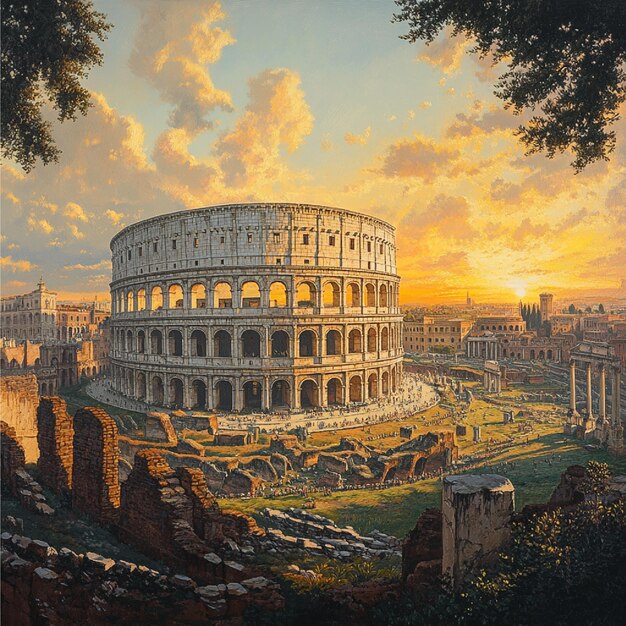The Colosseum: A Multifaceted Amphitheater Through the Ages
The Colosseum, an iconic symbol of ancient Rome, stands as a testament to the architectural prowess and societal intricacies of the Roman civilization. This
amphitheater
, located in the heart of Rome, Italy, was built during the reign of Emperor Vespasian (A.79) and completed by his son, Titus, in A.80. Originally referred to as the Amphitheatrum Flavium, it was designed to accommodate an estimated audience of 50,000 spectators, who would gather to witness the grandeur of Roman entertainment.
The Colosseum: A Stage for Spectacles
The amphitheater served as a venue for various forms of entertainment, including gladiatorial games, mock sea battles, and reenactments of famous battles. The spectacles were often held in honor of important Roman figures or to celebrate victories, thereby strengthening the connection between the rulers and the populace.
The Colosseum: A Symbol of Engineering Marvel
Beyond its entertainment value, the Colosseum also represented a remarkable feat of engineering. Its elliptical shape and complex design allowed for efficient crowd control, effective drainage systems, and the use of advanced hydraulics to raise stage floors. The construction materials included volcanic ash, travertine limestone, and tuff, which were carefully selected for their durability.
The Colosseum: A Beacon of Historical Significance
Over the centuries, the Colosseum‘s significance has extended beyond its original purpose. It has become a symbol of Roman history, as well as an enduring inspiration for modern architecture and urban planning. The structure has undergone numerous restorations throughout history, with many efforts taken to preserve its architectural integrity.
The Colosseum: A Continued Focal Point
Today, the Colosseum remains a major tourist attraction, drawing millions of visitors each year. It continues to be studied by historians and archaeologists, offering valuable insights into the ancient world and the cultural practices that shaped it.
The Colosseum: A Legacy of Ingenuity and Artistry
In essence, the Colosseum embodies the ingenuity and artistry of ancient Rome. Its multifaceted role as a stage for entertainment, a marvel of engineering, a symbol of historical significance, and a continuous source of inspiration makes it a truly remarkable structure that continues to captivate our imagination and fuel our curiosity.

The Colosseum: A Multifaceted Amphitheater
Introductory Remarks: The Colosseum, an iconic symbol of Imperial Rome, stands as a testament to the grandeur and power of ancient civilizations. Located in the heart of Rome, Italy, this colossal amphitheater has captured the imagination of millions throughout its ancient and modern history.
A Brief Description of the Colosseum
Construction: The Colosseum, built between 70-80 AD, is the largest amphitheater ever constructed in the Roman world. It could accommodate over 50,000 spectators, making it an impressive architectural feat that continues to amaze visitors today.
Iconic Status: The Colosseum’s iconic status is evident from the fact that it is one of the most recognized landmarks in the world. Its image graces countless postcards, books, and documentaries. Furthermore, the Colosseum has been the setting for numerous movies, including “Gladiator” and “The Fall of the Roman Empire.”
Thesis Statement
Functional Evolution: The Colosseum is more than just a monument; it has served various functions throughout its long history. Initially, it was used for entertainment, providing the ancient Romans with gladiatorial contests, mock sea battles, animal hunts, and staged plays. However, the amphitheater also served political propaganda purposes by showcasing the power and wealth of the Roman Empire to its citizens and visiting dignitaries. Additionally, the Colosseum represented architectural innovation, showcasing techniques such as the use of concrete vaults and arches that would influence Western architecture for centuries to come.

